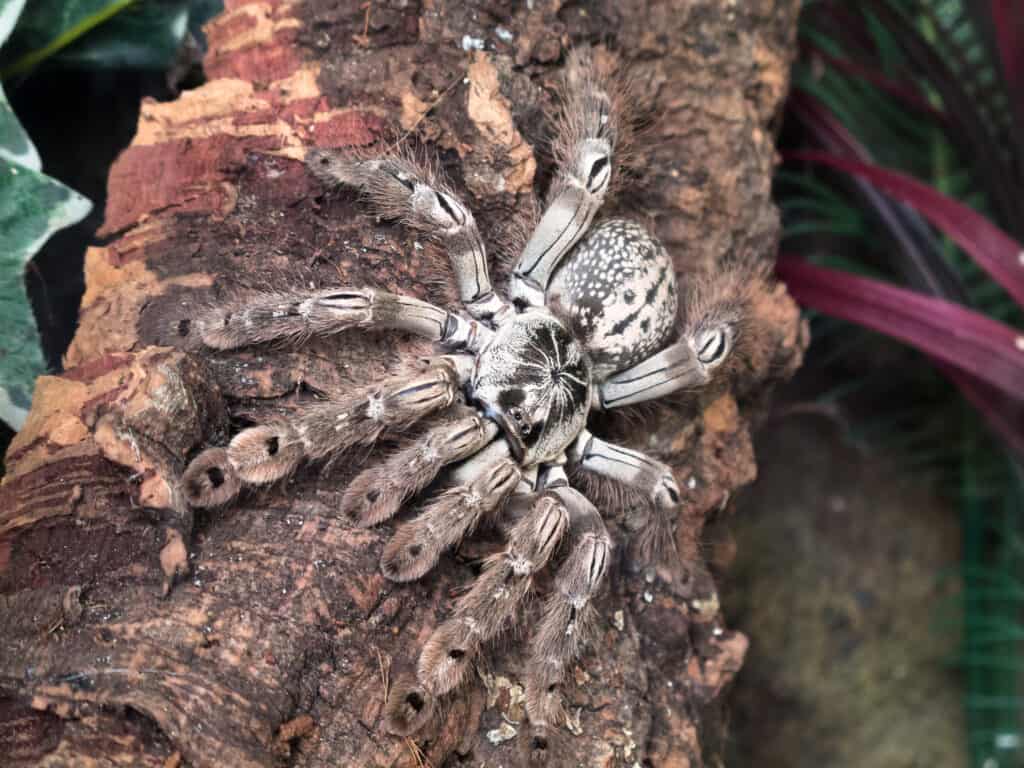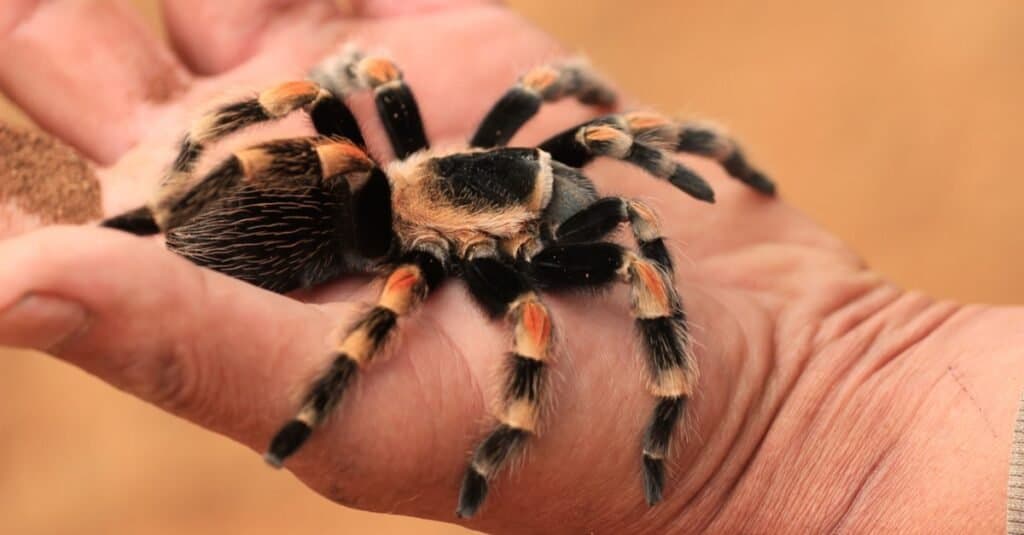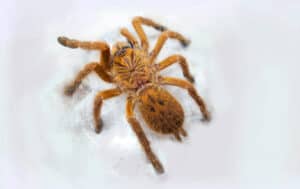Quick Answer:
- Tarantulas molt because they need to shed their preexisting skin in order to grow.
- They have an external skeleton (exoskeleton) made of chitinous material that is rigid and flexible but does not expand in size to allow for the animal’s growth.
- Younger spiders molt about once a month, while older ones may only molt 1-2 times a year.
Animals with exoskeletons, such as arachnids and insects, don’t grow the same as mammals or birds. They have to shed their skin periodically at key phases of their lifecycle. If you keep a tarantula as a pet, one of the key things you should know about is tarantula molting. According to Cornell University, about 85 percent of arthropods’ deaths happen during their molting phase. This may be due to injury, predator attacks, or even difficulty extracting themselves from their old exoskeleton. This is why it is vital that you learn how often tarantulas molt, why they do it, and the precautions you need to take during this delicate period of your spider’s life. Here’s a simple guide to tarantula molting and all you should know about it.
Tarantula Molting—Why Do They Do It?

Tarantulas grow by molting.
©SteveSimonsPhotography/Shutterstock.com
All spiders (and, by effect, all tarantulas) shed their skin. While this behavior might be strange, the reason they do it is pretty straightforward: tarantulas need to molt to grow. The skin of insects and spiders isn’t like ours. With humans, we have an internal skeleton covered by a layer of muscles and skin, and both can grow together.
Tarantulas have an external skeleton (exoskeleton) made of chitinous material. This unique fiber is rigid and flexible, protecting the spider from injury while allowing an impressive range of motion. Some parts of this exoskeleton may even be flexible. But this body armor cannot change size or grow. So how do tarantulas manage to grow as large as four to five inches?
The answer to that question is molting. Since the hard exoskeleton does not grow in size as the spider does, it’ll need to get rid of this old exoskeleton to grow. Shedding the old skin allows the spider to expand in size while a new exoskeleton grows to replace the previous one. This is why molting occurs.
How Do Tarantulas Molt?
As with many natural processes, molting in spiders is an impressive process. Once it is time to molt, the spider’s body will start releasing hormones that make the molting process possible—allowing the breakdown of the inner elastic layer of the spider’s skin. The spider reabsorbs this layer while the rigid outer layer remains in place to protect the spider until the new exoskeleton is fully formed.
The spider’s body then secretes a new exoskeleton larger than the old one. It is soft at first and folded under the old exoskeleton. With the new skeleton fully formed, the tarantula’s body will begin to enlarge, filling the new exoskeleton and breaking the old one. After the old exoskeleton breaks, the spider grows even more until the new exoskeleton is fully hardened and firm. This completes the molting process.
Although tarantulas can molt upright, they typically lie on their back or side. The entire molting process can take between 15 minutes to a whole day, depending on the species and size of the spider. The older your spider is, the longer the molting process will take.
How Often Do Tarantulas Molt?
The frequency of molting often depends on several factors, but the most important one is the age of your spider. Since spiders need to shed their old skin to grow, younger spiders tend to molt more frequently than older ones. Your old tarantula may molt just once a year or two. Younger spiders molt about once a month—growing bigger each month.
Signs of Molting
Many people are alarmed when they find their tarantula lying on its back or side. However, this is nothing to fret about. Spiders tend to take unnatural positions like this when it is time to molt. This is one of the surest signs that molting is about to start or is ongoing. Since molting is such a delicate time for your pet, you must know the important signs to watch out for when the process is about to begin. Some of the signs of molting in tarantulas include:
- Low appetite: Tarantulas often eat less or stop eating entirely in the days or even weeks leading up to their molting.
- Low activity: Although tarantulas are typically docile, they become even more slow and sluggish when it is time for them to molt.
- Bald spots and dull coloration: Generally, tarantulas have hairs all over their body. However, when it’s time to molt, you may notice bald spots on different parts of their body, especially the abdomen. The bald spot often disappears as the hair is restored after shedding. Also, as soon as they start the molting process, their exoskeleton will most likely turn a duller shade of grey,
- Increased webbing: you may notice your tarantula produces more webbing during the molting period. Typically, it’ll prepare a webbed bed or mat out of silk on which it can molt comfortably.
- Hiding: although this is not always the case, some spiders tend to hide during molting. Tarantulas may make a burrow in the substrate and cover the entrance with silk.
How To Get Ready for Tarantula Molting
As soon as you notice the above-stated signs of molting in your spider, it would help if you start getting ready for it. Tarantulas are more likely to grow successfully if the temperature and humidity in the tank are right. Check and adjust the humidity level to ensure it is just right for your type of tarantula.
Bear in mind that your spider is weaker and more susceptible to injury and illness during the molting period. You should keep their tank as clean as possible, and you can get rid of any uneaten prey to avoid issues like this. However, you can keep a bowl of water in the enclosure.
A sudden change of appetite in your pet is often a reason to worry for most pet parents. However, since reduced appetite is often a sign of molting, there’s no reason to be alarmed. You can make food available but don’t force your spider to eat in the days prior to molting.
Caring for Your Tarantula After Molting

Provide enough food and water once the molting is over.
©Vladimira Pufflerova/Shutterstock.com
Keep an eye on your tarantula during the entire molting process. As soon as molting is over, you’ll notice significant changes in your spider’s appearance. You may also find the old exoskeleton somewhere in the arthropod’s cage. You can remove this with a pair of tweezers. Most people simply throw it out, but the exoskeleton is a great way to monitor your spider’s growth. Your spider should return to its normal feeding schedule within a few days. Be sure to provide enough water and food once the molting process is over.
Experts often recommend waiting a few days (or up to a week) before feeding a newly molted tarantula. Since this spider is usually fed with live prey, providing them too early might be dangerous as their “yet-to-harden” exoskeleton can be easily damaged by fighting prey.
Up Next
The photo featured at the top of this post is © iStock.com/waldru
Sources
- Snake Tracks, Available here: https://www.snaketracks.com/tarantula-molting-process/
- Terminix (1970) terminix.com/blog/bug-facts/why-do-spiders-molt/
Thank you for reading! Have some feedback for us? Contact the AZ Animals editorial team.






